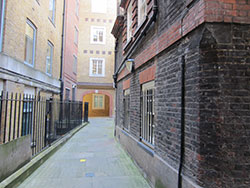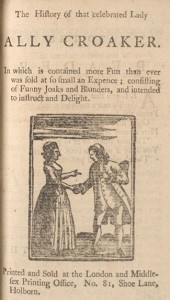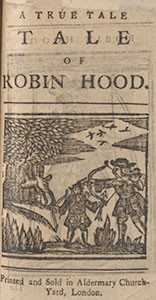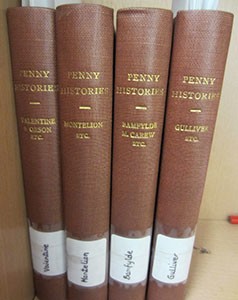 I would love to have wandered around Fleet Street and this area of London’s alleyways and lanes before the banking corporations supplanted the newspaper offices and severed the unbroken link to the area’s printing history that had stretched back so many years.
I would love to have wandered around Fleet Street and this area of London’s alleyways and lanes before the banking corporations supplanted the newspaper offices and severed the unbroken link to the area’s printing history that had stretched back so many years.
In the back streets of this historic centre of the British book trade, at addresses like Shoe Lane, Bow Church Yard and Red Lion Court, all a stone’s throw from the Maughan Library, small volumes of stories and fables and tales known as chapbooks were once printed – their geographical provenance enduringly visible through imprints like: Printed and sold at the London and Middlesex Printing Office, no. 81, Shoe Lane, Holborn.
 In my current cataloguing project I have been adding these little, well-thumbed volumes to the Special Collections catalogue.
In my current cataloguing project I have been adding these little, well-thumbed volumes to the Special Collections catalogue.
The chapbooks I have been working on were printed and produced in the later 18th century, though versions of chapbooks existed from the 17th to the 19th century. These were usually produced on hand operated printing presses in small industrial units, with family members sometimes employed at the stages of production. Chapbooks were normally printed on one single sheet of paper and then folded into 8, 12, 16 or 24 pages. They would usually have been sold unbound and held together by a simple sewing.
When you walk through the narrow, high-walled alleyways around Fleet Street, Holborn Circus and St Paul’s (as I do often on my lunch breaks) it is not difficult to imagine the printers, workshop assistants, agents and delivery boys scurrying through the streets in pursuit of their occupation and living.
As easy as it is to imagine these scenes of production, it is also no stretch of the imagination to imagine the itinerant ‘chapmen’, from whom the books take their name, bargaining with printers and agents, buying chapbooks wholesale, and then heading out of town with them tucked inside their bags, ready to sell to country folk at fairs and festivals. The soubriquet ‘chapmen’ derives from an Old English word meaning ‘dealer’ or ‘seller’.
 As literacy levels grew in the 18th and 19th centuries, the desire for these affordable, pithy tales also grew, and the stories that I have been working on include recognisable derivatives of the literary canon:
As literacy levels grew in the 18th and 19th centuries, the desire for these affordable, pithy tales also grew, and the stories that I have been working on include recognisable derivatives of the literary canon:
The travels and adventures of Capt. Lemuel Gulliver (abridged to a concise 24 pages)
A true tale of Robin Hood (true being an oft used word in titles, not always reflecting the veracity of the content)
The sleeping beauty in the wood
The tales are usually adorned with charming (and sometimes suggestive) woodcut illustrations. This was a cheap and durable method of illustration: woodcuts can be used for long periods and passed from one printer to another and, as Ruth Richardson says in her excellent British Library article on chapbooks, in the more expensive editions, children were sometimes employed to colour these woodcut illustrations.
 The chapbooks I have been working on were bound together in the 20th century by an independent firm on behalf of the Library. Each bound volume contains perhaps 10 or 15 of these wonderful tales on cheaply produced paper, that has evidently been thumbed through by readers of London or the country, and perhaps read aloud around a homestead fire as a bedtime treat for the family.
The chapbooks I have been working on were bound together in the 20th century by an independent firm on behalf of the Library. Each bound volume contains perhaps 10 or 15 of these wonderful tales on cheaply produced paper, that has evidently been thumbed through by readers of London or the country, and perhaps read aloud around a homestead fire as a bedtime treat for the family.
I like these books because I can sense the mechanics of their production in the streets where I work. In the Foyle Special Collections Library we hold examples of works from the infancy of printing (known as incunabula) to the present day, with grand editions, illustrations and provenance marking many out as significant, unique and of immense value to researchers and historians. These chapbooks have their special place in the collection, and there is something wonderful about the mass appeal that they offered, with their eclectic subject content covering heroic tales, ghost stories, battle and adventure and news and politics.
Their popularity is attested to by the well-thumbed pages, and also by the sparsity of detail on some of the imprints. This lack of detail in an imprint like ‘Printed and sold in London’ suggests that some printers may have been none-too-keen to display that they themselves had also ‘cashed in’ on the popularity of a certain tale, with their anonymity ensuring the pirated edition would not be traced back to them.
I have been reporting these editions to the English Short Title Catalogue (ESTC) to ensure they are accessible to researchers worldwide; and of course if anyone would like to have a look at these wonderful little volumes, they are welcome to consult them in the Foyle Special Collections Library.
Select Bibliography
The Bibliographical Society. Chapbooks Working Group.[http://www.bibsoc.org.uk/about/committees/chapbooks] Accessed 20 July 2016
EDPOP. ‘The European dimensions of popular print culture’. [http://edpop.wp.hum.uu.nl/] Accessed 20 July 2016
The National Art Library Chapbooks Collection [http://www.vam.ac.uk/content/articles/n/national-art-library-chapbooks-collection/] Accessed 20 July 2016
Victor E Neuburg. Chapbooks: a guide to reference material on English, Scottish and American chapbook literature of the eighteenth and nineteenth centuries. London: Woburn Press, [1972]. Foyle Special Collections [Special Collections Ref.] Z6514.P7 NEU
Ruth Richardson. ‘Chapbooks’. [http://www.bl.uk/romantics-and-victorians/articles/chapbooks], accessed 15 July 2016
Andrew White Tuer. Pages and pictures from forgotten children’s books. London: The Leadenhall Press, 1898-1899. Foyle Special Collections [Miscellaneous] PR91 TUE